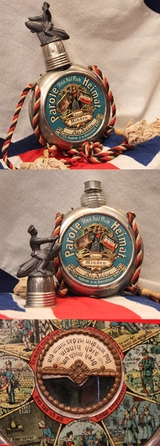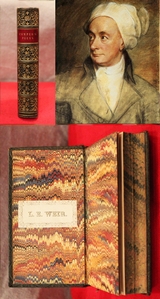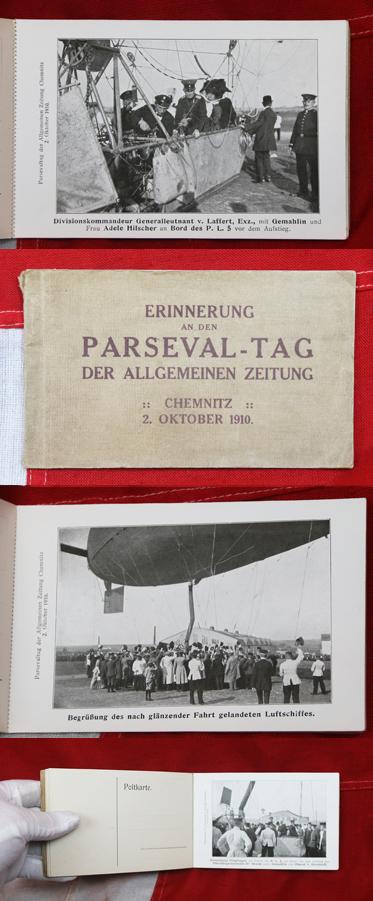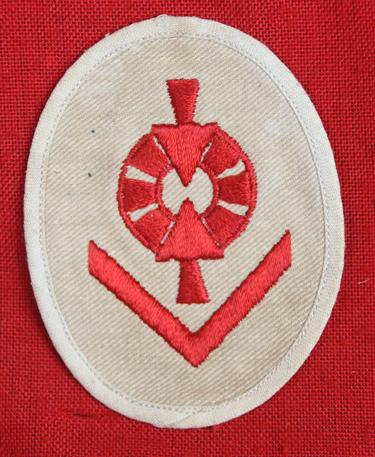A Most Decorative Imperial German WW1 Soldiers Zeppelin Flask
This is a superb WW1 German Reservists flask (Reservistenflasche). A glass schnapps flask encased in a decorative enamelled metal jacket, with a lanyard in the black, white,black and red colours of the Imperial German Reich. They were made by between 1871 and 1918, for sale to conscripts, wives or sweethearts of soldiers as a memento of their service time. The front and rear of the flask are covered in military themed vignettes, with, a military regimental panel attached to the front, and to the rear a rotating panel surrounded with picture portraits of pretty ladies. The lid is a cup of a soldier sitting astride a Zeppelin that turns to become a drinking cup. Named for the Minden Regt. The figure on the Zeppelin in lacking one arm. read more
245.00 GBP
A Wonderful Collection of Cowper's Evocative Poetry. Stunningly Bound
A wonderful size pocket edition. If there was ever a single poet who should be read by every higher education student Cowper is the one. Poems by William Cowper of the Inner Temple. In two books, within this single volume of 480 pages. Printed for Longman and Co. Paper Ex Libris label of L E WEIR. George Cowper was an English poet and hymnodist. One of the most popular poets of his time, Cowper changed the direction of 18th century nature poetry by writing of everyday life and scenes of the English countryside. In many ways, he was one of the forerunners of Romantic poetry. Samuel Taylor Coleridge called him "the best modern poet", whilst William Wordsworth particularly admired his poem Yardley-Oak. He was a nephew of the poet Judith Madan. The stages of William Cowper's life: forced into a career in the law that he did not want, forbidden from marrying the woman he loved, and insensed by certain religious and political views of his cousin, can be found within the lines of his verse. His words very much encapsulate the zeitgeist of the late 1700s. The religious tone of The Task, its domesticity, and its treatment of such topics as slavery and consideration for animals, are all anticipated themes associated with the evangelical revival which began in the late 1780s. The clash between Cowper's horror at his cousin's theories and his sense of family and personal obligations unleashed a great burst of creative energy. In the four months from December 1780 to March 1781 Cowper composed 2700 lines of verse, moral satires, in pentameter couplets. This portrait of a man divided particularly demonstrates the conflicting nature of the era. In decorative full calf bindings. Externally beautiful with most handsome tooling with only a little wear to the extremities. Generally very bright and clean with just occasional light spotting on the last two pages. 5.25 x 3 x1 inches approx. read more
135.00 GBP
A Rare King Airship Co. of Washington, USA, an Original & Historic, One Share Stock Certificate, Signed and Dated 7th August 1920
This would make an intriguing a unique gift, especially for a devotee of early aeronautica, and the earliest flying machines, and would look beautiful suitably framed.
On December 17, 1903, the Wright brothers were the first to fly in a powered and controlled aircraft. Previous flights were lighter than air vehicles, gliders (control but no power) or free flight (power but no control), but the Wright brothers combined both, setting the new standard in aviation records.
There have been many booms and busts in the aviation industry. The earliest known aviation stock certificate for a company that actually made a flying airship called the Novelty Air Ship Company in 1888. The Novelty Air Ship Company manufactured the vehicle for Professor Peter C. Campbell who was the inventor. Unfortunately, the air ship was lost at sea in 1889 while being test flown by Professor Hogan during an exhibition flight. This historic document was printed by the Goes Company and has an ornate border around it with a vignette of a Bald eagle. This item has the signatures of the Company’s Secretary and the President and is over 100 years old. read more
235.00 GBP
A Most Rare Airship Parseval Tag 8 Postcard Booklet Set, Chemnitz, Dated 2nd October 1910. a Wonderful Piece of early Airship Aeronautica & Postal Service Ephemera
Parseval day 2nd October 1910, 8 postcard booklet erinnerung an den parseval-tag. Chemnitz
The Parsevals were 22 airships built between 1909 and 1919 by the Luft-Fahrzeug-Gesellschaft (LFG) following the design of August von Parseval. In the 1920s and 1930s, three more airships were built following the Parseval-Naatz (PN) design.
As with the rival Zeppelins, the airships were, in both English and German, referred to by the name of the inventor. (In German, the nouns were masculine, that is, "der Parseval", "der Zeppelin".)
In contrast to the Zeppelins, the Parsevals were non-rigid or semi-rigid airships, with little or no stiffening structure inside the fabric envelope. The Zeppelins had a rigid internal framework made of duralumin. Both types relied on hydrogen gas to provide lift.
Original early Parseval airship postcards are very collectable indeed, and can fetch from £30 to £40 each, but a near complete book of 8 unused cards is really rare to find and a great aeronautical gem, plus with early air post connections read more
245.00 GBP
Congratulations To Nat Edwards, The New Master of the Armouries at the Tower of London & Director General
Royal Armouries newly appointed director general, Nat Edwards, joins the Royal Armouries from the renown Thackray Museum of Medicine in Leeds.
Nat Edwards was previously the chief executive officer of Thackray Museum of Medicine in Leeds where he has overseen a £4m refurbishment of the venue since joining in 2018. He has worked in the sector for more than 30 years, including roles at the Science Museum Group, National Library of Scotland, National Trust for Scotland and Glasgow Museums.
The Royal Armouries has sites in Leeds, HM Tower of London and Fort Nelson in Hampshire. It employs about 190 staff and receives about 2 million visitors a year across its three venues.
Courtesy of the Museums Association
We were most honoured to receive a personal invitation by Nat to his first formal patrons event at the Tower, including a personal tour of the Line of Kings. read more
Price
on
Request
British WW2 Anti Hitler Propaganda Pamphlet "Ein Peinliches Versprechen" An Embarrassing Promise
From a small former intelligence officer's collection of original surviving WW2 psychological warfare propaganda leaflets we were delighted to acquire.
"ein peinliches versprechen". An air dropped propaganda leaflet pointing out that Hitler prophesied a German victory in 1941, as the Year of Final Victory. Undermining the Fuhrer Myth through Black Propaganda and clandestine means became the stated objective of the OSS.
Leaflets for propaganda, could be dropped by balloons and planes over enemy territory, or, distributed by hand when in occupied or allied territory. They was used heavily in both world wars by all sides. In World War II, special bombs were developed to disperse airborne leaflets. Used as a form of psychological warfare, these leaflets were dropped in enemy-controlled territory to incite fear, coerce surrender, or turn the populace against their leadership. This tactic proved to be largely ineffective, except when morale among troops was extremely low. Leaflet bombs are still used today in military warfare, as well as by radical political and ideological groups.
Toward the end of World War II, Germany dropped millions of propaganda leaflets on enemy lines to encourage troops to surrender. Some of these leaflets were tailored to African American soldiers and suggested they would be treated better as German prisoners of war than as citizens in their own country.
Nazi Germany was not known for its fair treatment of people of African descent, or any persons who weren’t Aryan. Black people were frequently vilified and deemed uncivilised in Nazi propaganda. Yet, Germany was willing to use any tactics necessary to avoid defeat, including highlighting American racism, to exploit existing tensions within the U.S. military..
Although these pamphlets were made in their tens of thousands almost all were destroyed either immediately or at the wars cessation, so few survive and mostly survive today in national archives or museums.
8.25 inches x 5.25 inches read more
35.00 GBP
A Most Interesting & Historical Nazi Propaganda Leaflet Written by Notorious British Nazi and Traitor, John Amery, Who Was Executed At the Wars End
From a small former intelligence officer's collection of original surviving WW2 psychological warfare propaganda leaflets we were delighted to acquire.
An anti-Semitic propaganda leaflet printed in English, by infamous traitor John Amery, the Amery family's black sheep fascist, and the son of Churchill's Secretary of state for India. It was intended for distribution to British soldiers and civilians, a double-sided propaganda leaflet, entitled "Why Die for Stalin? Why die for the Jews?" and authored by British fascist and propagandist JOHN AMERY (1912-1945), who was tried and executed for treason postwar. The leaflet features the usual conspiratorial pabulum explaining that British soldiers are dying fruitlessly for Jewish and communist interests in Italy, Burma and on the Atlantic, while attempting to explain the fruitlessness of hostilities between England and Germany.
Leaflets for propaganda, could be dropped by balloons and planes over enemy territory, or, distributed by hand when in occupied or allied territory. They was used heavily in both world wars by all sides. In World War II, special bombs were developed to disperse airborne leaflets. Used as a form of psychological warfare, these leaflets were dropped in enemy-controlled territory to incite fear, coerce surrender, or turn the populace against their leadership. This tactic proved to be largely ineffective, except when morale among troops was extremely low. Leaflet bombs are still used today in military warfare, as well as by radical political and ideological groups.
Toward the end of World War II, Germany dropped millions of propaganda leaflets on enemy lines to encourage troops to surrender. Some of these leaflets were tailored to African American soldiers and suggested they would be treated better as German prisoners of war than as citizens in their own country.
Nazi Germany was not known for its fair treatment of people of African descent, or any persons who weren’t Aryan. People of colour were frequently vilified and deemed uncivilised in Nazi propaganda. Yet, Germany was willing to use any tactics necessary to avoid defeat, including highlighting American racism, to exploit existing tensions within the U.S. military. And by the wars end they even encouraged foreign Muslims to join the dedicated Muslim waffen SS regiments, which in the 1930's would be unthinkable.
Although these pamphlets were made in their tens of thousands almost all were destroyed, either immediately on landing or at the wars cessation, so very few indeed survive and mostly survive today in national archives or museums.
On 22 June, the Second Armistice at Compiègne was signed between France and Germany. Amery resided in the territory belonging to the collaborationist Vichy government led by Marshal Philippe Pétain. However, his personality soon antagonised the Vichy Regime so he made several attempts to leave but was not allowed. The head of the German Armistice Commission offered Amery a chance to live in Germany to work in the political arena but he was unable to get Amery out of occupied France.
In September 1942, Hauptmann Werner Plack gained Amery the French travel permit he needed, and in October Plack and Amery travelled to Berlin to speak to the German English Committee. It was at this time that Amery suggested that the Germans consider forming a British anti-Bolshevik legion. Adolf Hitler was impressed by Amery and allowed him to remain in Germany as a guest. During this period, Amery made a series of pro-German propaganda radio broadcasts, attempting to appeal to the British people to join the war on communism.
British Free Corps
The idea of a British force to fight the communists languished until Amery encountered Jacques Doriot during a visit to France in January 1943. Doriot was part of the LVF (Légion des Volontaires Français), a French volunteer force fighting alongside the Germans on the eastern front.
Amery rekindled his idea of a British unit and aimed to recruit 50 to 100 men for propaganda purposes and to establish a core of men with which to attract additional members from British prisoners of war. He also suggested that such a unit could provide more recruits for the other military units made up of foreign nationals.
Amery's first recruiting drive for what was initially to be called the British Legion of St George took him to the Saint-Denis POW camp outside Paris. Amery addressed between 40 and 50 inmates from British Commonwealth countries and handed out recruiting material. This first effort at recruitment was a complete failure, but he persisted.
Amery's drive for recruits found two men, of whom only one, Kenneth Berry, joined what was later called the BFC. Amery's link to the unit ended in October 1943, when the Waffen SS decided his services were no longer needed, and it was officially renamed the British Free Corps.
Arrest
Amery continued to broadcast and write propaganda in Berlin until late 1944 when he travelled to Northern Italy to lend support to Italian dictator Benito Mussolini's Salò Republic. On 25 April 1945, Amery was captured along with his French mistress Michelle Thomas by Italian partisans from the Garibaldi Brigade near Como. Amery and Thomas were initially to be executed, but both of them were eventually sent to Milan, where they were handed over to Allied authorities. Amery was wearing the uniform of the "Muti Legion", a fascist paramilitary organisation. The British army officer who took him into custody was Captain Alan Whicker, later known as a broadcaster.
Trial and execution
Amery was tried for treason in London. In a preliminary hearing, he argued that he had never attacked Britain and was an anti-Communist, not a Nazi. At the same time, his brother Julian attempted to show that John had become a Spanish citizen, and therefore would legally be incapable of committing treason against the United Kingdom.
His counsel, Gerald Osborne Slade KC, meanwhile, tried to show that the accused was mentally ill. Amery's sanity was questioned by his own father, Leo, but all efforts to have the court consider his mental state were unsuccessful. Further attempts at a defence were suddenly abandoned on the first day of his trial, 28 November 1945, when to general astonishment, Amery pleaded guilty to eight charges of treason, and was sentenced to death. The trial lasted just eight minutes.
Before accepting Amery's guilty plea, the judge, Mr Justice Humphreys, made certain that Amery realised the only permissible penalty would be death by hanging. After satisfying himself that Amery fully understood the consequences of pleading guilty, the judge announced this verdict:
John Amery ... I am satisfied that you knew what you did and that you did it intentionally and deliberately after you had received warning from ... your fellow countrymen that the course you were pursuing amounted to high treason. They called you a traitor and you heard them; but in spite of that you continued in that course. You now stand a self-confessed traitor to your King and country, and you have forfeited your right to live.
Amery was hanged in Wandsworth Prison on 19 December 1945 by executioner Albert Pierrepoint, who in his autobiography described Amery as "the bravest person I'd ever hanged", and buried in the prison cemetery. Amery actually quipped as he was led to the scaffold, "I've always wanted to meet you, Mr Pierrepoint, though not of course under these circumstances!" In 1996, Julian Amery had his brother's remains exhumed and cremated, scattering his ashes in France.
5 1/2" x 8" read more
185.00 GBP
A Superb Condition and Very Rare WW2 1943 Published Nazi & Vichy-French Propaganda Leaflet, Titled INTUITION With Swastikas and Portrait Photo of Adolf Hitler. Four Pages, Folded
From a small former intelligence officer's collection of original surviving WW2 psychological warfare propaganda leaflets we were delighted to acquire.
With photographs and propaganda quotes from such as Hitler, Goering, and Mussolini, showing the fallacy of their statements
For example; "Le mot dordre de la luftwaffe pour 1940 est; victoire"
translation "The Luftwaffe watchword for 1940 is; victory"
Goering 31st December 1939
"l'amitie entre italiens et allemands deviant tous les jours profinde"
translation "the friendship between Italians and Germans becoming deep every day"
Mussolini 2 December 1942
Leaflets for propaganda, could be dropped by balloons and planes over enemy territory, or, distributed by hand when in occupied or allied territory. They was used heavily in both world wars by all sides. In World War II, special bombs were developed to disperse airborne leaflets. Used as a form of psychological warfare, these leaflets were dropped in enemy-controlled territory to incite fear, coerce surrender, or turn the populace against their leadership. This tactic proved to be largely ineffective, except when morale among troops was extremely low. Leaflet bombs are still used today in military warfare, as well as by radical political and ideological groups.
Toward the end of World War II, Germany dropped millions of propaganda leaflets on enemy lines to encourage troops to surrender. Some of these leaflets were tailored to African American soldiers and suggested they would be treated better as German prisoners of war than as citizens in their own country.
Nazi Germany was not known for its fair treatment of people of African descent, or any persons who weren’t Aryan. Black people were frequently vilified and deemed uncivilised in Nazi propaganda. Yet, Germany was willing to use any tactics necessary to avoid defeat, including highlighting American racism, to exploit existing tensions within the U.S. military..
Although these pamphlets were made in their tens of thousands almost all were destroyed either immediately or at the wars cessation, so very few survive and mostly survive today in national archives or museums.
This one is particularly rare, in fact we haven't seen a surviving example before, certainly not in the past 50 years.
This is also a large size some could be only a few inches in size.
16.25 inches x 10.5 inches un-folded open.
read more
295.00 GBP
German WW2 Kriegsmarine Weapons Control Foreman Speciality Trade Badge
Sonderausbildung Abzeichen für Waffenleitvormann Truppen Ausbildung summer service rig.
On entering Kriegsmarine service all personnel were assigned and trained for a specific career. These careers consisted of a wide variety of speciality trades and functions with some of the careers restricted to certain rank groups. On successful completion of the appropriate training, personnel were issued distinctive career insignia to be worn on the upper left sleeve of the uniforms. For EM/NCO’s the career insignia could be worn combined with the rank insignia or as separate insignia. Enlisted ranks of Matrose up to and including Hauptgefreiter career insignia were generally embroidered on small round bases while NCO ranks of Maat up to and including Oberdeckoffizier career insignia were on larger, vertically oval bases and could come in embroidered or stamped alloy versions. Regulations dictated that the base colour of the insignia was to match the colour of the uniform it was worn on. Of Note: Rank designations were tied to the career the individual was assigned to. The insignia consists of a vertically oval, light weight, ribbed white cotton/rayon blend base with machine embroidered, upward and downward pointing, arrow dial heads superimposed on a circular base with staggered, outer graduation bars, all in bright red cotton threads, with larger red chevron. The outer edge of the white cotton/rayon base has a narrow white rayon reinforcement strip machine stitched in place. read more
38.00 GBP
A Very Desirable Early Neck Ribbon for a German WW2 Knight's Cross of the War Merit Cross
In two pieces. An extremely useful ribbon if one had a Knights Cross of the war Merit Cross lacking its ribbon. New replacement reproduction ribbon is available and relatively inexpensive, but old, early ribbon is another matter entirely.
The Knights Cross of the War Merit Cross was considered to be ranked higher than the German Cross in silver, but below the Knights Cross of the Iron Cross. A medal now valued between £4,000 to £10,000. A total of 118 awards of the Knights Cross of the War Merit Cross with swords, and 137 awards without swords were awarded. Considering the relative rarity of the award compared with the grades of the Knights Cross of the Iron Cross, it took on "extra meaning" it did not necessarily deserve, as it ranked below the Knights Cross of the Iron Cross. For example, Reichsmarschall Hermann Göring made a concerted effort to get Hitler to award him this order, much to Hitler's annoyance. In response, Hitler outlined a series of criteria governing the awarding of this decoration and the philosophy of such awards, and directed that "prominent party comrades" were not to be awarded with the Knights Cross of the War Merit Cross (or similar decorations), and withdrew the proposed awards of this order to Gauleiter Erich Koch and Herbert Backe. Directing his comments at Göring personally, Hitler ordered that such attempts to gain this award be stopped. Also, six persons received two Knights Crosses of the War Merit Cross (each one with and without Swords): Walter Brugmann, Julius Dorpmüller, Karl-Otto Saur, Albin Sawatzki, Walter Schreiber, and Walter Rohlandt. read more
240.00 GBP











